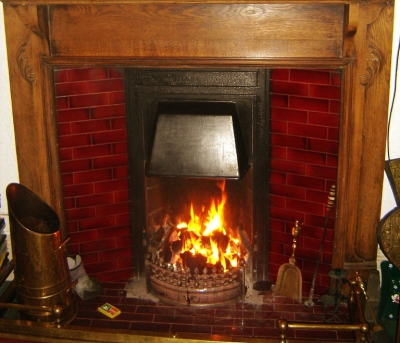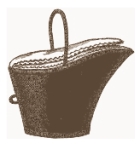-
History of:
- Resources about:
- More:
- Baby walkers
- Bakehouses
- Bed warmers
- Beer, ale mullers
- Besoms, broom-making
- Box, cabinet, and press beds
- Butter crocks, coolers
- Candle snuffers, tallow
- Clothes horses, airers
- Cooking on a peat fire
- Drying grounds
- Enamel cookware
- Fireplaces
- Irons for frills & ruffles
- Knitting sheaths, belts
- Laundry starch
- Log cabin beds
- Lye and chamber-lye
- Mangles
- Marseilles quilts
- Medieval beds
- Rag rugs
- Rushlights, dips & nips
- Straw mattresses
- Sugar cutters - nips & tongs
- Tablecloths
- Tinderboxes
- Washing bats and beetles
- Washing dollies
- List of all articles
Subscribe to RSS feed or get email updates.
...the andirons, or dogs, as they were termed, constructed for retaining the blazing firewood on the hearth, were wrought in the shape of lions...
Walter Scott, Woodstock, 1826 (set in 1651)
By fire-irons...the housekeeper and the ironmonger understand a fire-shovel, poker, and pair of tongs. These implements were not all of them found upon the ancient hearths of this country; nor were they all necessary when wood was burned upon a fire-place....The use of pit coal, and of close fire-places, led to the adoption of the poker now in universal requisition.
Robert Hunt, A Treatise on the Progressive Improvement & Present State of the Manufactures in Metal, 1853
...seasoned wood might at any time be wanted for the needs of the Navy. Therefore, any wood other than windfalls had to be bought as faggots [or] billets.... In 1666...billets [cost] 18 shillings a thousand...27 loads of faggots cost 14 pounds.
Gladys Scott Thomson, Life in a Noble Household 1641-1700, 1937
A warm fireside in winter
Lighting a fire
 In
northern parts of the world days are short and cold in the last weeks of the year. People there
want light and heat, and their festivals, like Halloween,
Martinmas and Christmas, are traditionally celebrated with extra lanterns
and fires. More important is daily warmth indoors. Being able to build and maintain a domestic fire was an important housekeeping skill in pre-electric days.
In
northern parts of the world days are short and cold in the last weeks of the year. People there
want light and heat, and their festivals, like Halloween,
Martinmas and Christmas, are traditionally celebrated with extra lanterns
and fires. More important is daily warmth indoors. Being able to build and maintain a domestic fire was an important housekeeping skill in pre-electric days.
Many writers on household topics seem to have taken it for granted that no explanation of fire-lighting was needed. As with washing, sweeping and scouring, people who needed to know could learn from family or fellow-servants. But Isabella Beeton gives a clear explanation of how to start a coal fire in a British fireplace. (Open fireplaces were much more popular in UK homes than closed stoves, while stoves were common in other parts of 19th century Europe.)
Fire-lighting, however simple, is an operation requiring some skill; a fire is readily made by laying a few cinders at the bottom in open order; over this a few pieces of paper, and over that again eight or ten pieces of dry wood; over the wood, a course of moderate-sized pieces of coal, taking care to leave hollow spaces between for air at the centre; and taking care to lay the whole well back in the grate, so that the smoke may go up the chimney, and not into the room. This done, fire the paper with a match from below, and, if properly laid, it will soon burn up; the stream of flame from the wood and paper soon communicating to the coals and cinders, provided there is plenty of air at the centre.
Isabella Beeton, Book of Household Management, 1861
 Coal can be arranged to suit a neat Victorian design like the one illustrated left.
A bigger, simpler fireplace - without a carefully-designed chimney, hood, and grate
- was better suited to burning wood. Before 18th and 19th century inventors got to work on improving
fuel efficiency, smoky rooms etc., wood was burnt on a wide open hearth. (And don't forget the traditional
Yule Log.) From the
Middle Ages onwards,
andirons, also
called fire dogs, have been used to hold burning logs.
Coal can be arranged to suit a neat Victorian design like the one illustrated left.
A bigger, simpler fireplace - without a carefully-designed chimney, hood, and grate
- was better suited to burning wood. Before 18th and 19th century inventors got to work on improving
fuel efficiency, smoky rooms etc., wood was burnt on a wide open hearth. (And don't forget the traditional
Yule Log.) From the
Middle Ages onwards,
andirons, also
called fire dogs, have been used to hold burning logs.
Wood bought for the fire used to come as faggots or billets. (See left-hand column) Faggots were bundles of sticks or small branches; billets were chopped branches.
Peat fires were common in many areas of northern Europe.
Fire irons
In 17th century England and earlier a fire fork might well be the only hearth-side tool apart from the andirons, but tongs and a shovel or pan were possible too. In the 19th century a poker was always available, while fire forks had become less common.
To keep a coal fire burning well you need to be able to rearrange and refresh it with fire irons: the poker, tongs, and shovel now sometimes called a "companion set". (Below right) As well as the coal scuttle (left of the fireplace in the photograph or below left) there may be bellows (to stimulate flames by blowing in air) and perhaps a trivet or toasting fork. Other metalwork includes a fender around the hearth and an ashpan under the grate supporting the fire.
Cleaning and polishing the fireplace
 The
more paraphernalia you collect, the more you have to clean and polish. In
Victorian and early 20th century Britain it was not unusual for young housemaids
to get up at 5 on a dark winter morning to start cleaning out ashes and polishing
hearths before lighting the new day's fires. In grand country houses the footmen might help
by fetching coal scuttles freshly filled by a houseboy.
The
more paraphernalia you collect, the more you have to clean and polish. In
Victorian and early 20th century Britain it was not unusual for young housemaids
to get up at 5 on a dark winter morning to start cleaning out ashes and polishing
hearths before lighting the new day's fires. In grand country houses the footmen might help
by fetching coal scuttles freshly filled by a houseboy.
Bright grates require unceasing attention to keep them in perfect order. A day should never pass without the housemaid rubbing with a dry leather the polished parts of a grate, as also the fender and fire-irons.
Isabella Beeton, Book of Household Management, 1861
 Some cleaning tips from the 19th century seem obvious, others less so.
Some cleaning tips from the 19th century seem obvious, others less so.
- Spread a cloth in front of the hearth before starting.
- Sprinkle wet tea-leaves on ashes to stop them flying around.
- Polish bright steel fireplaces with a mixture of oil and bath brick (a brick of moulded chalky earth) or emery, or emery paper, or a large pebble, and/or a piece of leather covered in fine chain on one side.
- Black finishes need black-lead mixed to a thick paste with water. Brush on metalwork, brush off, then polish.
- Marble hearthstones can be washed with soap and water or a liquid made from bullocks' gall.
- Polish slate hearths with hot mutton fat.
Amazon USor Amazon UK
See also: Peat fires
 12 December 2007
12 December 2007
You may like our new sister site Home Things Past where you'll find articles about antiques, vintage kitchen stuff, crafts, and other things to do with home life in the past. There's space for comments and discussion too. Please do take a look and add your thoughts. (Comments don't appear instantly.)
For sources please refer to the books page, and/or the excerpts quoted on the pages of this website, and note that many links lead to museum sites. Feel free to ask if you're looking for a specific reference - feedback is always welcome anyway. Unfortunately, it's not possible to help you with queries about prices or valuation.



